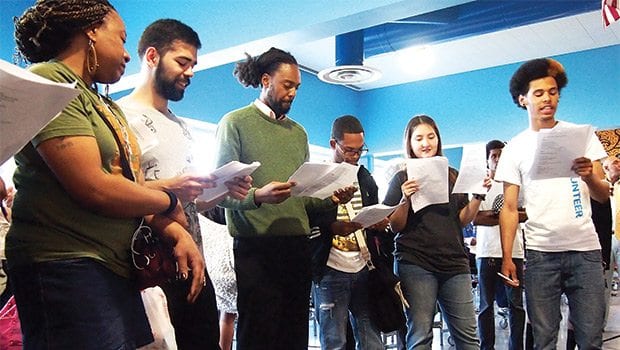Demonstrators disrupt BRA JP planning meeting
Call for greater affordability, delay in planning

BRA officials are in the home stretch of their Plan: JP/Rox process, culling community comments on future land uses and zoning for the corridor including Jackson Square, Egleston Square and Forest Hills. But not if affordable housing activists have their say.
Last week, as community members gathered at English High School viewed BRA poster board displays showing ideas for improvements to transportation, proposals for housing, jobs, economic development and open space, a contingent of more than 100 affordable housing activists marched into the room and read in unison a statement calling on the agency to suspend its planning process and increase the percentage of affordable units proposed for the area from 30 percent to 70 percent.
“All of us have been negatively affected by the BRA in this community and in this city,” the protesters said, reading in unison from a script. “We have tried talking at Plan JP/Rox meetings, but the BRA is not listening. That’s why we’re taking action tonight.”
The activists further called for 50 percent of new units to be for families earning less than $35,000 per year and 20 percent for those making $35,000 to $70,000 per year.

Activists outlined demands during a BRA planning meeting during which city officials solicited input from community residents on future development in the Jackson Square, Egleston Square and Forest Hills sections of Jamaica Plain.
“That’s who lives here now,” the protesters said. “That’s who should live here in the future.”
The demonstration comes as the BRA is preparing a draft of its overall blueprint for the planning area, which is bounded on the west by the Southwest Corridor railway and on the east by Columbus Avenue and Washington Street. The planning process is happening in the midst of a wave of displacement pitting longtime working class residents against newer renters and homeowners who can afford the rapidly rising rents and condo prices in the area.
“A friend of mine who lived up the street, my next door neighbor, they’re all being forced out,” said Paco Sanchez, a Fenway High School sophomore who has lived in the neighborhood for the last ten years. “You’re seeing a major shift in terms of race.”
The current residents, largely Latino and African American, are being displaced by young white professionals and students drawn to the area by its easy access to public transit and proximity to the already-gentrified sections of Jamaica Plain.
“If the community continues to change the way it’s changing, I’ll be gone, the people I know will be gone,” Sanchez said. “There will be no diversity in Jamaica Plain.”
The Egleston Square neighborhood where Sanchez and many of the other protesters live remains one of the last affordable areas in Jamaica Plain. But with a tight rental market in Boston and property values rising virtually everywhere in the city, Egleston Square residents are feeling the pressure.
Investors are planning or have begun half a dozen development projects there in the year, including the 76-unit, six story 3200 Washington Street project, which last year drew protests from the same group of demonstrators.
While the Boston Redevelopment Authority plan calls for 30 percent of new units developed in Jamaica Plain to be affordable, the demonstrators at last week’s event say the agency’s definition of affordable is often at odds with what most people living in Boston can pay.
The demonstrators say that the BRA’s definition of affordability — 60 to 70 percent of the HUD-defined area median income — would be affordable to families making up to $69,000 for a family of four. But with half of all families in Boston earning less than $35,000, few would be able to afford rents or home prices.
Under the current plan, market-rate developments in the planning area would be required to set aside 12 percent of their units as affordable. BRA Senior Planner Marie Mercurio said the agency is considering allowing developers to exceed height requirements — building, say, a six-story structure in an area zoned for four stories — if developers agree to increase the share of affordable units from 13 percent to 17 percent.
To arrive at its planned 30 percent, the BRA could set aside a portion of the vacant, city- or state-owned land in the area for developers of affordable housing. But along Washington Street in the Egleston Square area, such parcels are few.
BRA spokesman Nick Martin said the agency wouldn’t likely pause the planning process or halt development projects already underway.
“I think we’ve made it clear that a moratorium wouldn’t be feasible,” Martin said.
The protesters’ demand for 70 percent affordability is unreasonable, Martin added, given the lack of state and federal resources for affordable housing development.
“At a certain point, you have to consider what’s financially feasible,” he said. “Not all projects can dip into subsidies for affordability.”
The administration of Mayor Martin Walsh has committed to the creation of 53,000 new units of housing in Boston by 2030, greenlighting numerous projects over the last three years. While in recent years housing development has been concentrated mainly in downtown and high-rent neighborhoods, the push for new units has reached deeper into the city’s working class neighborhoods, including Dorchester and the Egleston Square area.
Walsh administration officials say the creation of new housing units will reduce pressure on the city’s overheated rental market and bring rents down.
But Kathy Brown, executive director of the Boston Tenant Coalition and a longtime Jamaica Plain resident, said the rate of displacement in the Egleston Square is alarming and that shiny new developments would likely increase displacement.
“People have a lot of concerns about who this development is for,” she said. “Given the rate of displacement in this city, this is a good time to step back.”
Mercurio said the agency will continue to solicit feedback from community members until it completes its plan for the corridor in July or August.


![Banner [Virtual] Art Gallery](https://baystatebanner.com/wp-content/uploads/2024/04/Cagen-Luse_Men-at-store-e1713991226112-150x150.jpg)



